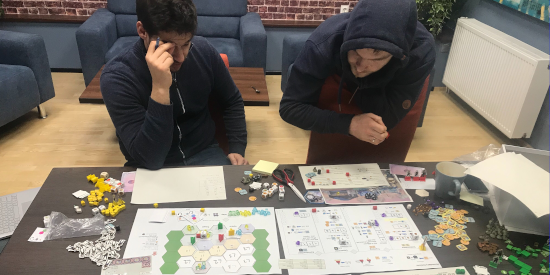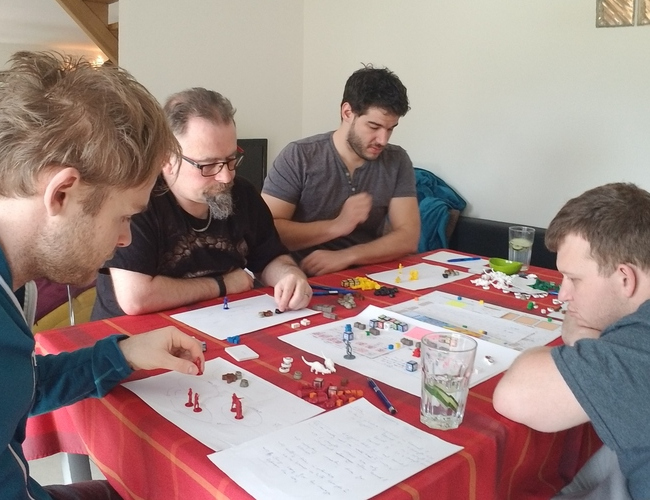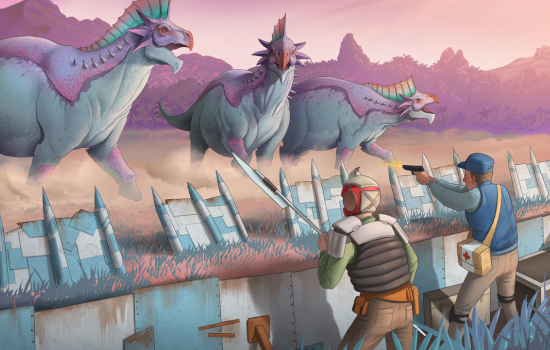The Episodic Concept
2020. March 24.

Viktor Peter
CEO & Head of Game Design
In my previous blog post (available here if you missed it), I reminisced a little on the very beginning of the Perseverance project and the journey of finding the theme we have today. To continue where we left off, today’s piece is about how the theme influenced our existing mechanisms, how it eventually led to the episodic concept - and exactly what that is.
Let me take you back to the first days of 2017. The whole team was excited for our newly found “shipwrecked survivors on a mysterious dinosaur island” theme, but obviously such a radical deviation from the original “vikings” theme required us to tweak (and even redesign) some of the core game’s mechanisms.
Overall, the new theme was a pretty good fit from the get go: the Assembly mechanism (a periodic scoring that rewards area majority in the settlement’s various districts), simulated the power struggles you would expect in a situation like this quite well, and the dice placement/dice influence was a great representation of you, an aspiring leader, trying to sway the ship’s best specialists to your cause. But the Adventures (previously Raids) needed some work: we really wanted them to feel risky and exciting but with sufficient player agency over the outcome - and, obviously, we also wanted to include the dinosaurs!
We had a lot of “wouldn’t it be cool if…” moments as we were tailoring the mechanisms to the new theme, and perhaps the most exciting of those was taking the Dinosaur inclusion to the next level: they were no longer just adversaries, but also potential allies! Tamed Dinos could help with the Adventures, either by carrying the adventure party or actually fighting, but that instantly begged the question: why not make use of them in the city as well? This led to us redesigning some of the city actions to incorporate the dinosaurs, which pushed the possibilities and the “epicness” of the game even further.

Once we were done, the game really had it all: a sprawling society in symbiosis with the dinosaurs; private and public buildings with lots of abilities; officers and districts to influence; a whole island to explore; and various dino types to fight or tame. Everything was connected and made sense, both thematically and mechanically, and we couldn’t have been happier with the result.

Yet, there was one thing that felt a little strange: even though each game played quite differently, resulting in various little stories each time, they always felt like the conclusion of another, much longer (and very exciting!) story. After all, the setting suggested that the survivors have been here for a long time, and it would be great to know what happened over those years. In addition, the game was (and still is) pretty complex with a lot going on, and it certainly could have benefitted from some sort of mechanical lead-up or tutorial.
It soon became obvious that we were unable to just “let it go” (as usual :) ), so we started throwing around ideas for a solution. Initially we wanted to do a simplified tutorial version with slightly different artwork on some of the components, but we soon realized that, both mechanically and thematically, the tutorial game should have been at least something unique. This realization inspired me to present something to the team I initially dismissed as “too ambitious”: the episodic concept.
In this concept, the people in our game were the descendants of the original shipwreck survivors, several generations down the line. The generations faced different challenges in establishing their presence on the island and they all had different stories. And the crazy idea was to make a game for each generation to actually tell you these stories, eventually leading to the setting of the game we had. We identified four episodes in the story of our stranded survivors.
1. Leaving the safety of the ship and trying to establish a foothold on the island while being constantly threatened by the dinosaurs;
2. Starting to grow the secured settlement into a city and setting out to explore the island;
3. Settling in for the “long run”, establishing a functioning society and learning to coexist with the dinosaurs (as described above);
4. Unraveling the mystery of the island (which I’m not going to spoil yet :) ) and reaching the epic conclusion.
So, four stories - four games! We wanted each one to be playable as a standalone game, but also to include a campaign mode where the outcome of each episode influences the next. Our design goal for each game was to have a healthy mix of two types of mechanisms:
1. “Signature” mechanisms of the series that are present in every episode, but also evolve over time (something to make players feel “at home” in each subsequent game). An example of this is the dice placement core mechanism, and the area majority scoring; both of which are in every episode with slight modifications and twists.
2. Enough unique mechanisms to stand its ground as a standalone game, and to have enough reason for you to play it over the others when in the mood. An example of this is how the survivors interact with the island and the dinosaurs, which is significantly different in every episode.

Finally, we wanted to gradually increase complexity so by the time the players get to Episode 3, the game we had originally, they know about 60% of the mechanisms and the complexity transition feels natural and smooth. We wanted the starting point, Episode 1, to be fairly accessible, but still a true Mindclash game.
As you see, there are many, many boxes to tick here, and the project is a huge challenge both creatively and mechanically - certainly true to its name! We’ve been working on the episodic concept since early 2018, but we are finally closing in on the finish line. I’m glad to be a part of such an amazing and dedicated team, and I’m confident that Perseverance will be something truly special when it sees the light of day!
That’s it for today! This concludes the overview of the scope and the concept of the project, but there are still many more stories to tell about the design and development of the individual Episodes in the upcoming posts.
Until next time,
Viktor